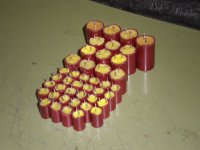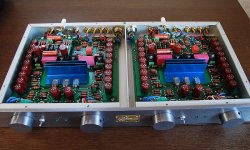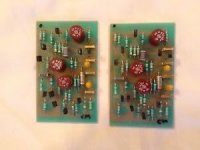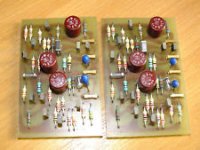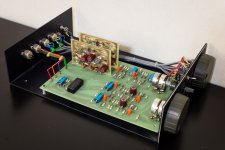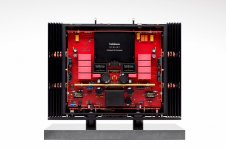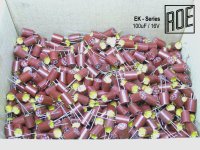Backes & Müller Beta
After 3 decades of service in an active (non-ventilated) loudspeaker ?
Gentlemen, saw this discussion today.
I have "lots" of experience with these caps.
You see the red caps with Roe and Siemens logo. I think both were made
in the Roederstrein plant. We used to order these on a regular basis and
when they arrived came as either R. or Siemens 35 years ago.
As said problems start after decades (sometimes one decade only) and in hot
environment. The plastic case (I don't think it is Bakelite ) can not withstand
thermal stress. The point with max. mechanical stress is on the top edge.
Sometimes the cracks are only visible with mag. glasses.
My experience: the absence of cracks does not guarantee proper function
and also a cracked cap may still have full capacitance. These caps will not
likely fail with a short, but:
They (as probably el. caps in general) don't like to be operated with low dc
voltages. A common point of failure is in a special breed of amps where they
are used for emitter ac coupling with only .5 to .6 volts dc. They may become
conductive with still full capacitance when used like this.
Philips caps with thin wrapped blue and light blue shrink cover are always
suspective. Same for old "Frako" with thin light green-yellow cover.
The red Roe caps have been available as bipolar types as stated here elsewhere.
Over decades I have rarely (if ever) seen any failure with these.
I don't replace them all, only the defective ones. For special gear I use NOS
of the same type in order to preserve originality. If you replace these caps in
precious gear with different ones it will loose its resale value. Another reason
is that they are believed to be sonically superior by some designers.
See also http://www.diyaudio.com/forums/parts/211422-help-id-capacitors-my-preamp.html
I have "lots" of experience with these caps.
Siemens also made very comparable caps, both in construction and quality. They also had an identical form factor (probably resulting from some old DIN standard). The only difference was the color: bright orange instead of dull brick. But the quality was very comparable. It was the GSF series.
You see the red caps with Roe and Siemens logo. I think both were made
in the Roederstrein plant. We used to order these on a regular basis and
when they arrived came as either R. or Siemens 35 years ago.
These capacitors were heavily used not only in TV sets, but also in high-end audio gear by Revox, Bang & Olufsen and others.
In my experience, these capacitors are the first things to replace when the equipment comes in for service. The top surface of many is cracked and they are dried out.
Maybe these capacitors where O.K. when new, but after a couple of decades, in my view they are no good anymore.
...
The dull red ROE elco's are really bad components and need to be replaced!
As said problems start after decades (sometimes one decade only) and in hot
environment. The plastic case (I don't think it is Bakelite ) can not withstand
thermal stress. The point with max. mechanical stress is on the top edge.
Sometimes the cracks are only visible with mag. glasses.
My experience: the absence of cracks does not guarantee proper function
and also a cracked cap may still have full capacitance. These caps will not
likely fail with a short, but:
They (as probably el. caps in general) don't like to be operated with low dc
voltages. A common point of failure is in a special breed of amps where they
are used for emitter ac coupling with only .5 to .6 volts dc. They may become
conductive with still full capacitance when used like this.
Under the same conditions, the Philips ones were awful (the ones with light blue sleeve): they simply dried up, without stress, and they even degraded under shelf storage conditions.
Philips caps with thin wrapped blue and light blue shrink cover are always
suspective. Same for old "Frako" with thin light green-yellow cover.
I have never seen bipolars in this series (which doesn't mean they don't exist).
The red Roe caps have been available as bipolar types as stated here elsewhere.
The grey and orange caps are of earlier manufacture.I found some more in my stock, including the grey one.
Over decades I have rarely (if ever) seen any failure with these.
Hi,
my experience with those dull-red ROE capacitors is that they are very prone to failure after about 25 years.
They were heavily used by Bang & Olufsen and Revox since about 1970.
The first advice of all service technicians that I know, is to replace these capacitors, in whatever audio brand they are used.
I don't replace them all, only the defective ones. For special gear I use NOS
of the same type in order to preserve originality. If you replace these caps in
precious gear with different ones it will loose its resale value. Another reason
is that they are believed to be sonically superior by some designers.
See also http://www.diyaudio.com/forums/parts/211422-help-id-capacitors-my-preamp.html
Last edited:
I don't know: the Siemens always measured marginally but consistently better than the same capacitance/voltage from RoeYou see the red caps with Roe and Siemens logo. I think both were made
in the Roederstrein plant. We used to order these on a regular basis and
when they arrived came as either R. or Siemens 35 years ago.
I use a home-brewed esr meter. Description here for example:
http://www.diyaudio.com/forums/parts/199046-oldies-but-goodies.html
http://www.diyaudio.com/forums/parts/199046-oldies-but-goodies.html
I have examined some samples in details: at first sight, they look very similar: identical case dimensions (but it could be down to some DIN standard), similar case thermoset material (except for color of course), similar sealing epoxy resin.
However, when you look with less naive and more technical eyes, there are some telling differences: tiny details like the shape of the feet or the transfer-moulding flash are different, which means they come from different moulds.
This doesn't mean they come from different factories: they could have two (or more) sets of machines, and they may even have actively cultivated some minor differences, just to be able to prove that the brands are actually different.
This is not an uncommon practice: look at some Aldi and Lidl products for example.
I still don't know; all I can tell is that the Siemens ones were always somewhat better, but it could result from an end of process screening...
However, when you look with less naive and more technical eyes, there are some telling differences: tiny details like the shape of the feet or the transfer-moulding flash are different, which means they come from different moulds.
This doesn't mean they come from different factories: they could have two (or more) sets of machines, and they may even have actively cultivated some minor differences, just to be able to prove that the brands are actually different.
This is not an uncommon practice: look at some Aldi and Lidl products for example.
I still don't know; all I can tell is that the Siemens ones were always somewhat better, but it could result from an end of process screening...
Aluminum bodied caps sound quite a lot like aluminum, due to the field integration with the casing, under delta load. Which is what a cap does, in an audio circuit.... thus, a notable amount of the sound of an aluminum cased cap is coming from the leads and the casing. <snip>
You're really right !

I've tried Panasonic FC years ago, 'bout '88 if I remember right ...
... whacked 'em in a nice DIY phono-pre I lashed together in my spare time.
The 'new' Bakelites I have stashed for the NEW phono-pre, aren't dried out or cracked at all ...
... tip top & Bristol in fact !

So should be hunky dory ... I recon.
Si.
Helmut must have collected a giant stock of the Red Roederstein EK series
Why? Just so he has something to service in some years time?

GIANT stock of Roederstein EK !
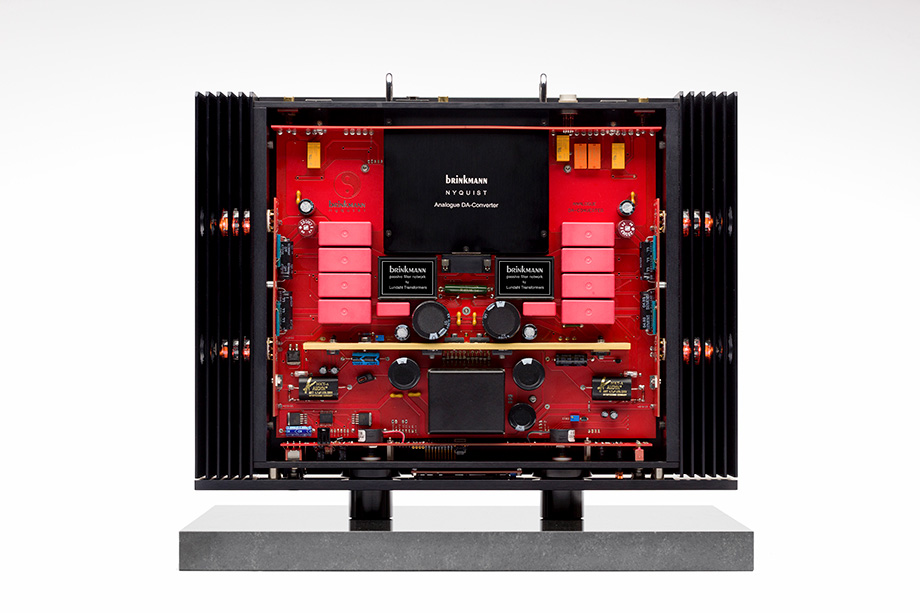
" Brinkmann Nyquist DAC, released at the 2017 Munich High End show in May, $18000
Helmut must have collected a giant stock of the Red Roederstein EK series "
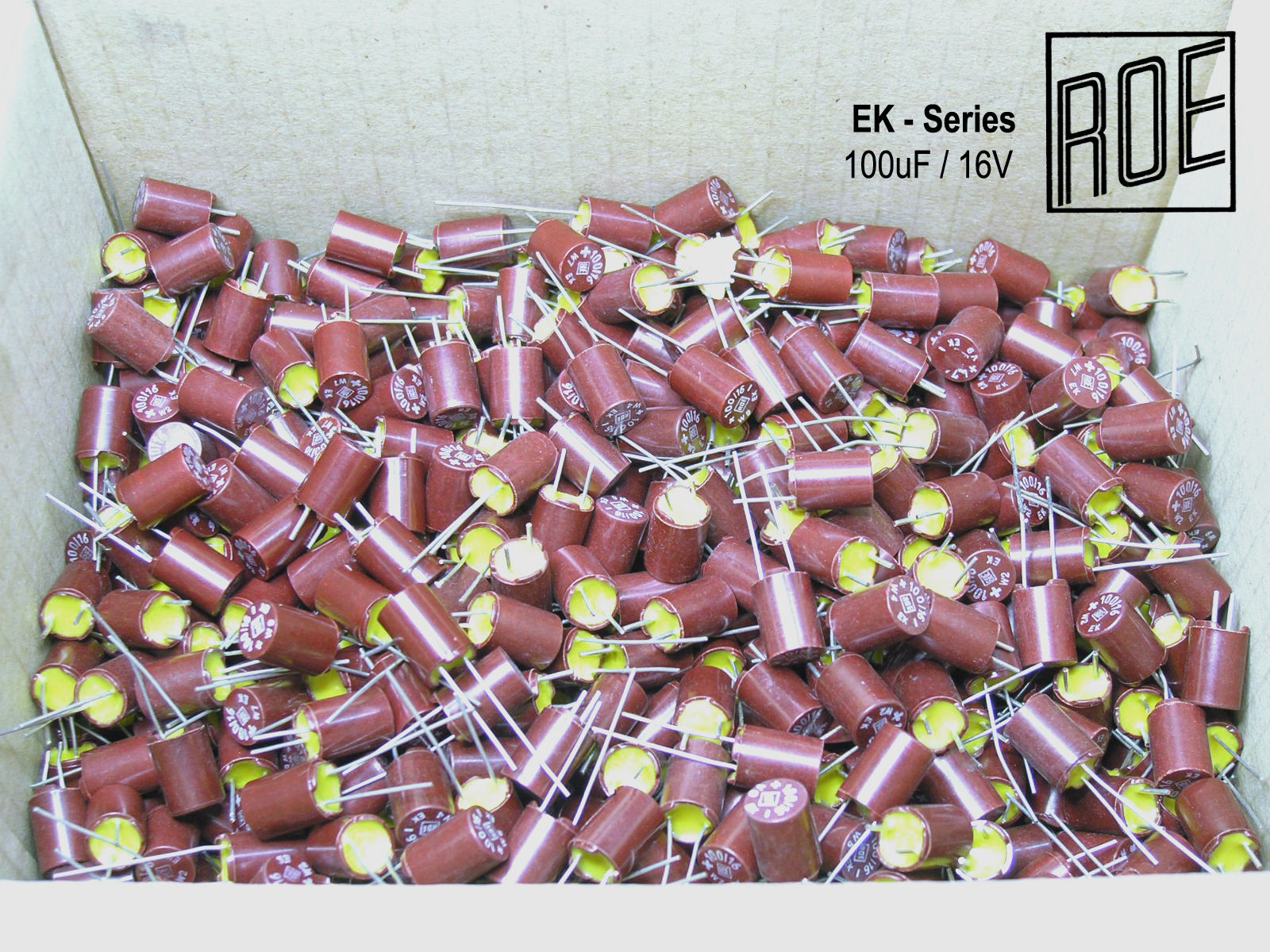
Don't forget to POST EARLY for Christmas !

Si.
.
" Brinkmann Nyquist DAC, released at the 2017 Munich High End show in May, $18000
Helmut must have collected a giant stock of the Red Roederstein EK series "
Don't forget to POST EARLY for Christmas !

Si.
.
Attachments
Last edited:
- Status
- This old topic is closed. If you want to reopen this topic, contact a moderator using the "Report Post" button.
- Home
- Design & Build
- Parts
- Roederstein 'BAKELITE' series EK capacitors - "Living Legend" OR "Looney Legacy" ...?
